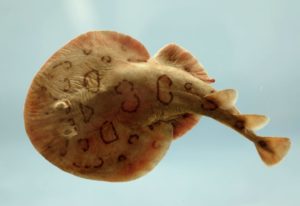
The lesser electric ray, a small sand-dwelling ray that lives from North Carolina to Brazil, has been considered one of the most endangered marine fish on Earth. A 2005 paper reported that 98% of these rays had been wiped out, a decline attributed to shrimp trawling bycatch. This paper resulted in these animals getting classified as IUCN Red List “Critically Endangered,” the highest risk category for any species that is still found in the wild.
A new paper published today in the journal Endangered Species Research shows that these rays are in much better shape than previously believed. “There is no evidence of a decline in the relative abundance of lesser electric rays,” said Dr. John Carlson, a NOAA Fisheries Service Research Biologist and lead author of the new paper.
This new analysis is great news for lesser electric rays, but how can two papers that analyzed the same dataset result in such drastically different conclusions? It comes down to an important assumption that the 2005 paper made. “These authors did not address the fact that major changes were made in the trawl survey design which resulted in a drastic decrease in the intensity of sampling within the central Gulf of Mexico,” Dr. Carlson said. “This decrease reduced the probability that randomly selected sampling sites would occur on spatially discrete areas of suitable habitat for lesser electric rays in the region. The lesser electric ray exhibits a patchy distribution over their range and they are fairly abundant in specific habitats while consistently absent from others.”
In other words, while the sampling survey data analyzed in the 2005 paper did include a drastic reduction in the number of lesser electric rays caught, this isn’t because of a change in population of rays. It is actually because researchers changed how frequently they were sampling in the habitats where lesser electric rays live. Once this change in sampling design was taken into consideration and the data from the IUCN Red List assessment was re-analyzed, the reported 98% population decline disappeared. “Taken together, the trend in abundance is relatively flat with high variability within each time series,” Dr. Carlson said. “This is not surprising based on the clumped and patchy distribution over shallow, sandy habitats utilized by this species in the western North Atlantic Ocean.”
The new paper points out that claiming that a species is more threatened than it really is can have harmful consequences. “It is critical that the best possible information be used when considering the conservation status of a given species to minimize undue burdens and ensure that increasingly limited resources are applied to the recovery of those species that are truly in peril,” the authors wrote. They are also calling for a re-evaluation of the IUCN Red List status of lesser electric rays.